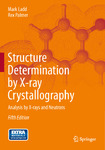Structure Determination by X-ray Crystallography
Abstract
We were honoured to be asked by Springer, New York to prepare a fifth
edition of Structure Determination by X-ray Crystallography. First published
in 1977 under the Plenum imprint, this book has received wide acclaim in
both teaching and research in X-ray crystallography because of its extensive
and detailed coverage of all aspects of the subject.
As we prepare this new edition, we are entering the centenary of the
discovery of X-ray diffraction in 1912, the beginning of X-ray crystallography
as a science in its own right. Today, X-ray crystallography and the
complementary technique of neutron diffraction together provide the most
powerful tools for the investigation and elucidation of crystal and molecular
structures. X-ray and neutron crystallography may be described as the science
of the structure of materials, in the widest sense of the phrase, and their
ramifications are evident across a broad spectrum of scientific endeavour.
The power of computers and available software has unleashed an unprecedented
ability to carry out with speed the complicated calculations involved
in crystal structure determination on a desktop PC. This is paralleled by the
availability of powerful X-ray and neutron sources and low temperature
devices for facilitating measurements at liquid nitrogen temperature or
lower, which provide ever higher precision in the determination of crystal
structures. However, a detailed knowledge of the theory underlying the
process of crystal structure determination is still required in order both to
ensure that the literature contains correct well-determined structures and to
understand the complexities introduced by features such as disorder and
twinning in crystals. There are many pitfalls in crystal structure determination
to trap the unwary.
In this new edition, we have continued the approach that has been well
reviewed in its earlier editions. We have always kept in mind that students
meeting X-ray crystallography for the first time are encountering a new discipline,
and not merely extending the range of a subject already studied. In
consequence, we have chosen, for example, to discuss the geometry and symmetry
of crystals in rather more detail than is found in other books on this
subject, for it is our experience that some of the difficulties that students meet in
introductory X-ray crystallography lie in their unfamiliarity with a three dimensional
concept,whether they be final-year undergraduate or post-graduate
students in chemistry, biochemistry,materials science, geology, bioinformatics,
information technology, or physics. Both low molecular weight (small
molecules) and macromolecular methods (proteins) are covered in detail.

